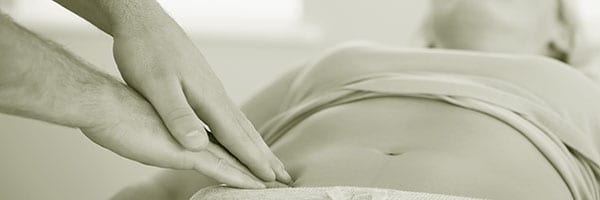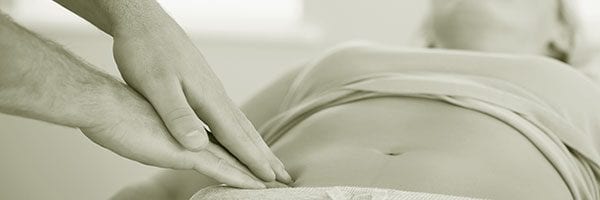Pelvic floor dysfunction (PFD) is a common condition in women with endometriosis and other pelvic pain conditions and occurs when the muscles that form the pelvic floor have tightened in response to chronic pelvic pain. Even after the original source of pelvic pain has been resolved, PFD persists as an acquired or secondary source of pelvic pain. In severe cases, the patient suffers from pelvic floor spasms, which can be excruciating and make intercourse impossible. Other common symptoms are pain and/or difficulty emptying the bladder or bowel and painful intercourse. Pelvic floor dysfunction can affect all the organs in the pelvis, including the urinary, genital, and bowel systems, and can have further reaching effects on the body (coordination, alignment, breathing, and mobility).
Pelvic Floor Dysfunction is a common condition in women with endometriosis and other pelvic pain conditions and occurs when the muscles that form the pelvic floor have tightened in response to chronic pelvic pain.
Once a woman’s endometriosis has been successfully removed during surgery and healing is complete, if pain persists, she may be assessed for PFD and referred to our specialized pelvic floor physical therapist. Most physiotherapists lack the training and expertise to treat pelvic pain and pelvic floor spasm. If you are seeking relief of PFD it is important to find a practitioner who understands the specific needs of women with endometriosis and who has experience and training in treating PFD.
What happens during pelvic floor physical therapy and how does it help?
Chronic pelvic pain can affect body posture, muscle tone and alignment. Muscles may become shorter, tighter and misaligned due to the perpetual responses of the body to pelvic pain. The role of the pelvic floor physical therapist is therefore to train the patient to relax her body and restore balance and alignment. While the pain emanates from the pelvis, the effects of chronic pain are far-reaching due to the role of the pelvic floor in core activities such as movement and coordination. Effective physiotherapy may need to involve muscle groups throughout the body.
Patient history
Pelvic physical therapy begins with a thorough patient history. In her own words, the patient tells her story about living with endometriosis, her pain and the treatments she has endured. She is also asked to recant any other incidents in her life history that might have jolted her pelvis, such as a previous skiing accident.
Biomechanical and musculoskeletal assessment
The next step is a biomechanical and musculoskeletal assessment; the therapist observes how the patient moves and walks, her posture and breathing, where her core areas of pain are, and takes note of the overall condition of her muscles (strength, coordination, alignment, and contraction).
Relaxation skills
Following this general assessment, the therapist focuses on relaxation skills. Massage is directed at loosening and relaxing muscles and relieving abdominal and pelvic pain. The patient is then directed in self-massage and relaxation exercises, which she can continue at home.
Physical examination
Next the therapist performs a thorough physical exam to test overall body flexibility and mobility, paying particular attention to the hips and possible joint malformations, the sites of abdominal scars and the motility of the internal pelvic organs. The physical exam comprises both an external and internal exam. During the internal exam, the different layers of the pelvic floor are assessed to check muscle spasm, tone and mobility, tissue rigidity and pain trigger points. While some patients may feel uncomfortable, internal work is essential in order to access the core muscles and tissues involved by PFD.
Retraining of muscles
Pelvic muscles that have been identified as tense and in spasm are then “down trained” by teaching the patient the difference between tensing and relaxing these muscles. This can be achieved with the help of biofeedback sensors placed on the muscles so that the patient can see her pelvic muscle activity fluctuate on the biofeedback monitor.
Home exercises
To improve flexibility and stretch tightened muscles, the patient will be instructed in stretching exercises, focused on opening the hips. The patient may also be instructed in vaginal dilation exercises to be performed digitally or with a home-dilation kit to further mobilize tissue within the pelvis. Further exercises will focus on core strength, and trunk and spine flexibility. Once pain and mobility improve, the patient will be retrained in basic movements such as walking and standing without tensing the pelvic floor and to improve pelvic-girdle coordination. The patient will be instructed in gentle exercises to restore coordination and mobility, such as basic yoga and Pilates, gradually building up over the course of 6 to 12 weeks.
Pelvic floor physical therapy helps chronic pelvic pain sufferers to retrain and recalibrate their bodies, reversing the harmful effects of ongoing pain on the body. The goal is to improve (sexual, bladder and bowel) function, coordination, core strength and to relieve pain.






Hello my name is weldon dial. I have been suffered from pelvic floor dysfunction for a long time. my pt told me to do kegels every day and she used biofeedback. the problem went away but now its back. I suffer from SEVERE depression. I was wondering if i should be doing kegels or not. I would love to have help from your clinic. thanks
Definitely not! If your pelvic muscles are already tense (assuming this from the PFD) then kegels will make it worse unless it’s “reverse kegels”. If the muscles are already tight, making them tighter (the point of kegels) will make the pain and tightness worse!